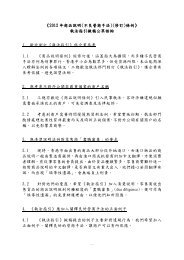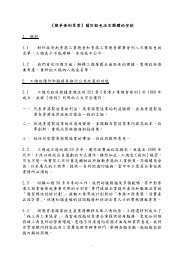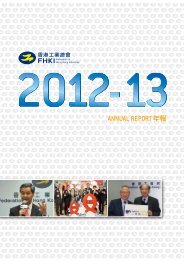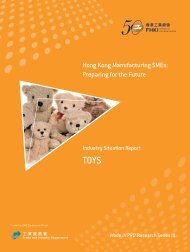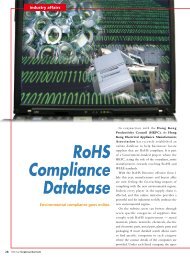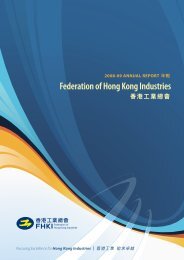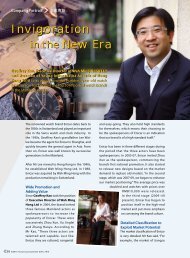Hong Kong Manufacturing SMEs: Preparing for the Future
Hong Kong Manufacturing SMEs: Preparing for the Future
Hong Kong Manufacturing SMEs: Preparing for the Future
- No tags were found...
Create successful ePaper yourself
Turn your PDF publications into a flip-book with our unique Google optimized e-Paper software.
55The Consumer Electronics IndustryConsumer electronics refers to any device containingan electronic circuit board that is intended <strong>for</strong>regular use by individuals. This includes televisions,cameras, digital cameras, PDAs, calculators, VCRs,DVDs, audio devices, headphones, camcorders, andmany o<strong>the</strong>r home and office products.Consumer electronics companies engage ei<strong>the</strong>r inOEM, OBM, or ODM, or a combination of <strong>the</strong> three.The global consumer electronics industry is mainlydominated by branded companies from Japan,South Korea, Europe, and <strong>the</strong> US. These companiestypically concentrate research and development in<strong>the</strong>ir home country and place <strong>the</strong>ir manufacturingactivities throughout <strong>the</strong> world, with assembly oftenin <strong>the</strong> Chinese Mainland.China is one of <strong>the</strong> world’s largest consumerelectronics manufacturing bases. The 2009 ChinaStatistical Yearbook reports that <strong>the</strong> “communication,computer, and o<strong>the</strong>r electronic equipmentmanufacturing enterprises above designated size” 109in China employed 6.8 million workers, contributeda Gross Industrial Output (GIO) of RMB 4,390billion and value added tax (VAT) payable of RMB61.9 billion in 2008. 110 Electronics production inChina is concentrated in <strong>the</strong> Pearl River Delta and<strong>the</strong> Yangtze River Delta. Guangdong reported thatcommunication, computer, and o<strong>the</strong>r electronicequipment manufacturing enterprises in <strong>the</strong> provinceemployed 2.9 million workers, contributed a GIO ofRMB 1,537 billion and VAT payable of RMB 26 billionin 2008. 111Japanese and South Korean firms have developedglobally recognised brand names on <strong>the</strong> back oftechnological superiority. Taiwan firms are alsovery active, mostly on an OEM basis. <strong>Hong</strong> <strong>Kong</strong>companies have leveraged knowledge of markets,customers, technologies, and production locationsin <strong>the</strong> Chinese Mainland to carve out a positionin <strong>the</strong> industry. Firms from <strong>the</strong> Chinese Mainlandare considered to be in <strong>the</strong> early stages in termsof technology and brand development, but aredeveloping stronger positions and some haveintroduced <strong>the</strong>ir own brands into global markets. 112China has been increasing its strength as aproduction location <strong>for</strong> consumer electronics. Inaddition, <strong>the</strong> Chinese market is among <strong>the</strong> fastestgrowing in <strong>the</strong> world. Industry analysts note thatto a certain extent <strong>Hong</strong> <strong>Kong</strong> companies arecaught between <strong>the</strong> Japanese and Korean firmswho develop <strong>the</strong>ir own brands and products on <strong>the</strong>one hand, and firms from <strong>the</strong> Chinese Mainland,who have lower costs. In contract manufacturing,<strong>Hong</strong> <strong>Kong</strong> firms often face direct competitionfrom much larger Taiwanese companies. However,<strong>the</strong> electronics market is a large market with manyniches and <strong>Hong</strong> <strong>Kong</strong> companies have becomeskilled at supplying such niches. Thus, <strong>the</strong>re appearsto be room <strong>for</strong> creative <strong>Hong</strong> <strong>Kong</strong> companies thatcan find <strong>the</strong> right niches in <strong>the</strong> marketplace.Basic Facts about <strong>the</strong> IndustryThe global consumer electronics industry generatedrevenue of around US$694 billion in 2008 and isexpected to grow at a Compound Annual GrowthRate (CAGR) of around five per cent over <strong>the</strong>period 2010 to 2013. 113 The category that bestrepresents this sector in <strong>Hong</strong> <strong>Kong</strong> statistics is“Radio, television and communication equipmentand apparatus.” The GIO <strong>for</strong> this sector in <strong>Hong</strong><strong>Kong</strong> was HK$1.1 billion in 2008, employment was1,266, and <strong>the</strong> estimated average annual wagewas HK$134,281. Wages <strong>for</strong> <strong>the</strong> sector in <strong>Hong</strong><strong>Kong</strong> are four times those <strong>for</strong> <strong>the</strong> sector in Chinaas a whole. This is likely explained by general wagedisparities between <strong>Hong</strong> <strong>Kong</strong> and China as wellas <strong>the</strong> employment of more senior staff in <strong>Hong</strong><strong>Kong</strong>. Wages were approximately 16 per cent oftotal sector costs in <strong>Hong</strong> <strong>Kong</strong>. 114109 Enterprise above designated size refers to <strong>the</strong> enterprise withannual revenue of RMB 5 million or above.110 2009 China Statistical Yearbook.111 2009 Guangdong Statistical Yearbook.112 ESA interviews.113 www.reportlinker.com.114 <strong>Hong</strong> <strong>Kong</strong> Census and Statistics Department data on “Radio,television and communication equipment and apparatus,”2009.




